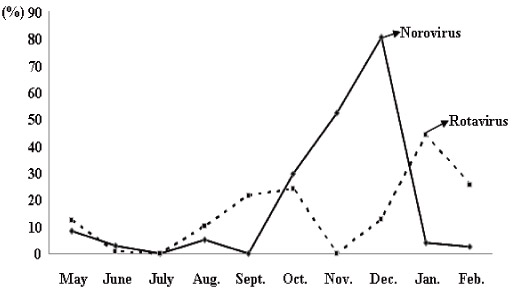Infect Chemother.
2010 Jun;42(3):143-148. 10.3947/ic.2010.42.3.143.
Comparison of Clinical Features of Norovirus and Rotavirus Gastroenteritis in Hospitalized Children and Norovirus Genotype Analysis
- Affiliations
-
- 1Department of Pediatrics, College of Medicine, Soonchunhyang University, Cheonan, Korea. allergist@korea.com
- 2Department of Clinical Pathology, College of Medicine, Soonchunhyang University, Cheonan, Korea.
- 3Department of Parasitology, College of Medicine, Soonchunhyang University, Cheonan, Korea.
- 4Department of Preventive Medicine, College of Medicine, Soonchunhyang University, Cheonan, Korea.
- 5Chungcheongnam-Do Health and Environment Research Institute, Daejeon, Korea.
- KMID: 2170301
- DOI: http://doi.org/10.3947/ic.2010.42.3.143
Abstract
- BACKGROUND
Norovirus is one of the most prevalent pathogens causing acute gastroenteritis in children. We compared the clinical features of noroviral gastroenteritis to those of rotaviral gastroenteritis and analyzed the noroviruses' genotype frequencies.
MATERIALS AND METHODS
Stool samples were obtained form 433 children hospitalized with acute gastroenteritis from May 2008 through February 2009 at Soonchunhyang University Cheonan Hospital and examined for the presence of norovirus or rotavirus. We then analyzed the clinical features of noroviral gastroenteritis in comparison with rotaviral gastroenteritis and observed the capsid protein gene sequences from the isolated norovirus for genotyping.
RESULTS
Norovirus was isolated from 69 patients (16.4%) and rotavirus from 49 patients (11.6%). The noroviral gastroenteritis patients experienced vomiting (77.4%), diarrhea (73.2%), and respiratory symptoms (53.6%); the rotaviral gastroenteritis patients experienced diarrhea (71.4%), dehydration (69.3%), and vomiting (65.3%). Dehydration in patients with noroviral gastroenteritis (43.4%) was rare compared with rotavirus (69.3%) (P=0.008). The isolated norovirus belonged primarily to the GII.4 genogroup (85.5%). Our phylogenetic analysis of the GII.4 isolates revealed 3 clusters, including novel cluster C.
CONCLUSIONS
Vomiting was the most common symptom in noroviral gastroenteritis patients. Dehydration in noroviral gastroenteritis patients was less common compared with rotavirus gastroenteritis patients. The majority of the norovirus strains isolated from children with acute gastroenteritis belonged to the GII.4 genogroup.
Keyword
MeSH Terms
Figure
Cited by 1 articles
-
Characteristics and Clinical Correlations of
Staphylococcus aureus Discovered in Stools from Children Hospitalized at a Secondary Hospital
Eun Hye Shin, Byung Wook Eun, Young Min An, Mi Ok Song
Pediatr Infect Vaccine. 2018;25(2):61-71. doi: 10.14776/piv.2018.25.e1.
Reference
-
1. Clark B, McKendrick M. A review of viral gastroenteritis. Curr Opin Infect Dis. 2004. 17:461–469.
Article2. Cheng AC, McDonald JR, Thielman NM. Infectious diarrhea in developed and developing countries. J Clin Gastroenterol. 2005. 39:757–773.
Article3. Parashar UD, Gibson CJ, Bresee JS, Glass RI. Rotavirus and severe childhood diarrhea. Emerg Infect Dis. 2006. 12:304–306.
Article4. Wilhelmi I, Roman E, Sánchez-Fauquier A. Virus causing gastroenteritis. Clin Microbiol Infect. 2003. 9:247–262.5. Im IJ, Lee MJ, Chung EH, Yu JS, Chang YP, Park WS, Park KS, Song NS, Baek KA, Cha YT. Etiology and clinical manifestation of acute gastroenteritis in children. Korean J Pediatr Infect Dis. 2006. 3:147–154.
Article6. Hyser JM, Estes MK. Rotavirus vaccines and pathogenesis: 2008. Curr Opin Gastroenterol. 2009. 25:36–43.
Article7. Chang JY. Updates on rotavirus vaccines. Korean J Pediatr Gastroenterol Nutr. 2007. 10:Suppl 1. 74–78.8. Kojima S, Kageyama T, Fukushi S, Hoshino FB, Shinohara M, Uchida K, Natori K, Takeda N, Katayama K. Genogroup-specific PCR primers for detection of Norwalk-like viruses. J Virol Methods. 2002. 100:107–114.
Article9. Chung JY, Huh K, Kim SW, Shin BM, Han TH, Lee JI, Song MO. Molecular epidemiology of human astrovirus infection in hospitalized children with acute gastroenteritis. Korean J Pediatr Gastroenterol Nutr. 2006. 9:139–146.
Article10. Koh H, Baek SY, Shin JI, Chung KS, Jee YM. Coinfection of viral agents in Korean children with acute watery diarrhea. J Korean Med Sci. 2008. 23:937–940.
Article11. Patel MM, Hall AJ, Vinjé J, Parashar UD. Noroviruses: a comprehensive review. J Clin Virol. 2009. 44:1–8.
Article12. Bass DM. Berman RE, Kliegman RM, Jenson HB, editors. Rotavirus and other agents of viral gastroenteritis. Nelson textbook of pediatrics. 2004. 17th ed. Philadelphia: WB Saunders Co;1081–1083.13. Ma SH. Acute infectious diarrhea in pediatric patients. Korean J Pediatr. 2005. 48:235–250.14. Thornton AC, Jennings-Conklin KS, McCormick MI. Noroviruses: agents in outbreaks of acute gastroenteritis. Disaster Manag Response. 2004. 2:4–9.
Article15. Chung JY. Acute viral gastroenteritis: recent trends and updates. Korean J Pediatr Gastroenterol Nutr. 2007. 10:Suppl 1. 53–57.16. Hong GS, Jeon HU, Choi WK, Namgoong MK, Kim JS. A study of relation between serum aminotransferase elevation and clinical symptoms from human rotavirus gastroenteritis. J Korean Pediatr Soc. 1995. 38:54–60.17. Kim HS, Jang MW, Kim CH, Lee HH, Yoo HJ. Clinical study of rotavirus gastroenteritis in the last 2 years. Korean J Pediatr. 2005. 48:1116–1120.18. Park TJ, Choi ES. The relation of serum transaminase concentration and dehydration in human rotavirus gastroenteritis. J Korean Pediatr Soc. 1990. 33:1662–1669.19. Hansman GS, Katayama K, Maneekarn N, Peerakome S, Khamrin P, Tonusin S, Okitsu S, Nishio O, Takeda N, Ushijima H. Genetic diversity of norovirus and sapovirus in hospitalized infants with sporadic cases of acute gastroenteritis in Chiang Mai, Thailand. J Clin Microbiol. 2004. 42:1305–1307.
Article20. Dey SK, Nguyen TA, Phan TG, Nishio O, Salim AF, Rahman M, Yagyu F, Okitsu S, Ushijima H. Molecular and epidemiological trend of norovirus associated gastroenteritis in Dhaka City, Bangladesh. J Clin Virol. 2007. 40:218–223.
Article21. Wu FT, Oka T, Katayama K, Wu HS, Jiang DS, Miyamura T, Takeda N, Hansman GS. Genetic diversity of noroviruses in Taiwan between November 2004 and March 2005. Arch Virol. 2006. 151:1319–1327.
Article
- Full Text Links
- Actions
-
Cited
- CITED
-
- Close
- Share
- Similar articles
-
- Clinical Spectrum of Norovirus Gastroenteritis Compared to Rotavirus Gastroenteritis at a Single Center in Gwanju, Korea during 2005-2006; Compared to Rotaviral Gastroenteritis
- Clinical features of acute noroviral gastroenteritis in children : comparison with rotaviral gastroenteritis
- Molecular Characterization of Norovirus and Rotavirus in Outbreak of Acute Gastroenteritis in Seoul
- Detection and Genotyping of Viruses Detected in Children with Benign Afebrile Seizures Associated with Acute Gastroenteritis
- Comparison of Clinical Features between Noroviral and Rotaviral Gastroenteritis




